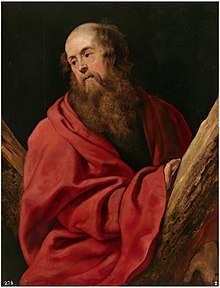
Back Andreas (apostel) Afrikaans Sant Andreu apóstol AN أندراوس Arabic ܐܢܕܪܐܘܣ ܫܠܝܚܐ ARC اندراوس ARZ Həvari Andrey Azerbaijani Andreas (Apostl) BAR Андрэй Першазваны Byelorussian Андрэй (апостал) BE-X-OLD Андрей Първозвани Bulgarian
Andrew the Apostle | |
|---|---|
 Saint Andrew (c. 1611) by Peter Paul Rubens | |
| Apostle, Martyr and Patron of Scotland | |
| Born | c. AD 5 Bethsaida, Galilee, Roman Empire |
| Died | AD 60/70[1] Patras, Achaea, Roman Empire |
| Venerated in | All Christian denominations which venerate saints |
| Major shrine | St Andrew's Cathedral, Patras, Greece; St Mary's Cathedral, Edinburgh, Scotland; the Church of St Andrew and St Albert, Warsaw, Poland; Duomo Cathedral in Amalfi and Sarzana Cathedral in Sarzana, Italy. |
| Feast | 30 November |
| Attributes | long white hair and beard, holding the Gospel Book or scroll, leaning on a saltire, fishing net |
| Patronage | Scotland, Barbados, Georgia, Ukraine, Russia, Greece, Cyprus, Romania, Patras, Burgundy, San Andrés (Tenerife), Diocese of Parañaque, Candaba, Pampanga, Masinloc, Telhado, Sarzana,[2] Pienza,[3] Amalfi, Luqa (Malta), Manila[4] and Prussia; Diocese of Victoria; fishermen, fishmongers, rope-makers, textile workers, singers, miners, pregnant women, butchers, farm workers, protection against sore throats, protection against convulsions, protection against fever, protection against whooping cough, Russian Navy, 75th Ranger Regiment Tables of Authority |
Andrew the Apostle (Koinē Greek: Ἀνδρέας, romanized: Andréas [anˈdre.aːs̠]; Latin: Andreas [än̪ˈd̪reː.äːs]; Aramaic: אַנדּרֵאוָס; Classical Syriac: ܐܰܢܕ݁ܪܶܐܘܳܣ, romanized: ʾAnd'reʾwās[5]), also called Saint Andrew, was an apostle of Jesus. According to the New Testament, he was a fisherman and one of the Twelve Apostles chosen by Jesus. The title First-Called (Πρωτόκλητος, Prōtoklētos) stems from the Gospel of John, where Andrew, initially a disciple of John the Baptist, follows Jesus and, recognizing him as the Messiah, introduces his brother Simon Peter to him.[6]
According to Eastern Orthodox tradition, the apostolic successor to Andrew is the Patriarch of Constantinople.[7]
- ^ Britannica, The Editors of Encyclopaedia. "St. Andrew". Encyclopedia Britannica, 28 May. 2019, https://www.britannica.com/biography/Saint-Andrew Archived 1 December 2021 at the Wayback Machine. Accessed 1 December 2021.
- ^ "Cattedrale di Sarzana".
- ^ Williams & Maxwell 2018, p. 300.
- ^ "HISTORY: The Church before it became a Cathedral: 1571". Retrieved 31 January 2023.
- ^ "Dukhrana – Andreas/Andrew/ܐܢܕܪܐܘܣ". Dukhrana.com. Retrieved 9 September 2020.
- ^ "BBC – History – St Andrew". www.bbc.co.uk.
- ^ Apostolic Succession of the Great Church of Christ, Ecumenical Patriarchate, archived from the original on 19 July 2014, retrieved 2 August 2014
© MMXXIII Rich X Search. We shall prevail. All rights reserved. Rich X Search